Boreal Forest/Taiga Biome
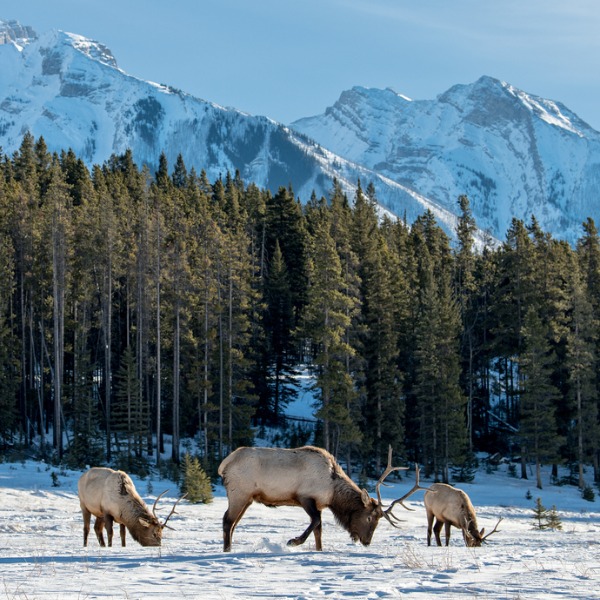
Wild elk in boreal forest, Banff National Park (Ferenc Cegledi, iStockphoto)

Wild elk in boreal forest, Banff National Park (Ferenc Cegledi, iStockphoto)
How does this align with my curriculum?
Learn about the location, plants, animals, human impacts and conservation of the boreal forest/Taiga biome and meet Anne-Claude Pépin who is a fire management technician.
The Terrestrial Biomes
The terrestrial world can be divided into areas called biomes. A biome is a large area of land classified by its plants and animals.
A biome is made up of many ecosystems. An ecosystem is the interaction of living and nonliving things in an environment.
Misconception Alert
An ecosystem is not the same thing as a biome. A biome is the specific geographic area in which ecosystems can be found.
In this backgrounder, major terrestrial biomes of the world are named based on the Whittaker classification scheme. This is not the only classification system because not all scientists agree on the number and types of biomes.
Distribution of the Earth’s Major Biomes
The map below shows where each of the eight major terrestrial biomes are located in the world. Canada contains four biomes. These are temperate deciduous forest, grassland, boreal forest/taiga, and tundra. A biome has the same characteristics no matter where in the world it is found. This means that the boreal forests of Canada look like the boreal forests of Russia.
The characteristics of each biome are dependent on its climate. Temperature and precipitation are the most important factors determining what living things can be found in a given biome.
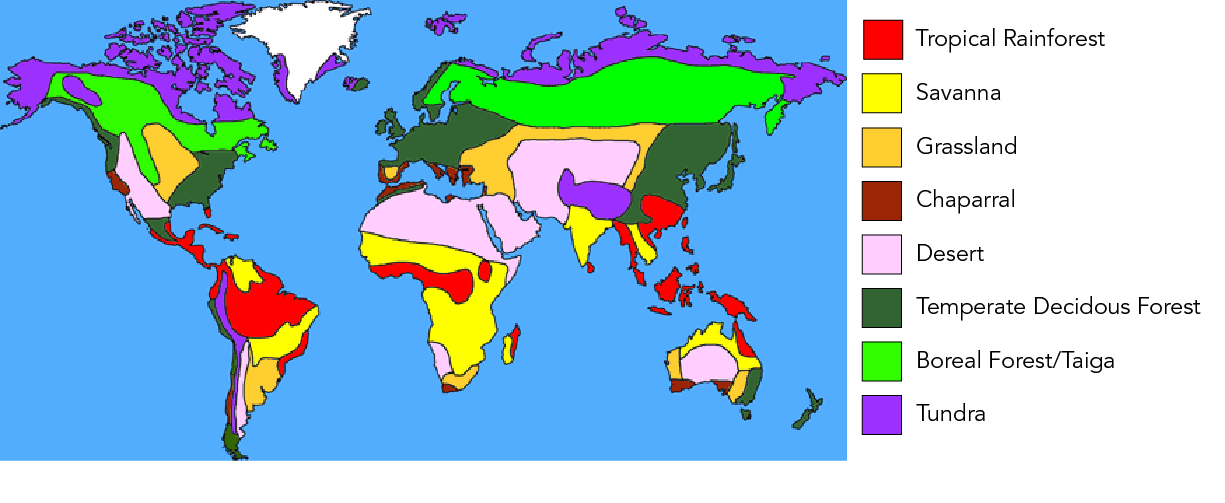
Major terrestrial biomes (Let’s Talk Science adapted from an image by Adapted from: H.J. de Blij and P.O. Miller. 1996. Physical Geography of the Global Environment. John Wiley, New York. Pp. 290.).
Image - Text Version
Shown is a colour world map illustrating the location of terrestrial biomes.
The map shows the world's oceans in blue, and its landmasses in stripes and blobs of eight different colours.
A legend on the right side identifies the biomes associated with each colour. Red is labelled "Tropical Rainforest." Yellow is labelled "Savanna." Gold is labelled "Grassland." Brown is labelled "Chaparral." Pink is labelled "Desert." Dark green is labelled "Temperate Deciduous Forest." Bright green is labelled "Boreal Forest/Taiga." Purple is labelled "Tundra."
Starting at the top, purple indicates Alaska, Canada's arctic, the tip of Greenland, Northern Russia, a strip close to the west coast of South America, and part of Central Asia, are tundra.
Below, most of southern Canada and Russia are bright green for boreal forest/taiga.
A gold blob in the middle of North America, another on the southeast coast of South America, a strip in an arc shape across part of the Middle East and southern Russia, a small part of the southeast coast of Africa, and small parts of the west and south coasts of Australia, indicate grassland.
Dark green appears on the west and east coasts of North America, the west coast of South America, large parts central and southern Europe, the UK, eastern Asia, the southeast corner of Australia, and all of New Zealand. This indicates temperate deciduous forest.
Pink areas are across the western United States, northern Mexico, a narrow strip of South America, most of North Africa and the tip of South Africa, Central Asia and the middle of Australia. These indicate desert.
The brown areas are small and scattered widely. They are along the southwest coast of the United States, the northeast coast and southern tip of Africa, most of Italy, Greece and Turkey, and small parts of southern Australia. These indicate chaparral.
Red is scattered across parts of the southern hemisphere. This includes Central America, northern parts of South America, a thin strip across most of Africa and the northern tip of Madagascar, most of Southeast Asia and the northeast tip of Australia. This indicates tropical rainforest.
Yellow is in two blobs in South America, most of the southern half of Africa, most of India, a small strip of Southeast Asia, and the northwest coast of Australia. This indicates savanna.
Boreal Forest/Taiga
Location
The boreal forest covers about 11% of Earth’s land mass. This makes it the world’s largest terrestrial biome! It is located in the northern hemisphere. It extends from around 50° North latitude to 65° N latitude.
The term “boreal forest” tends to refer to the southern part of the biome. The term “taiga” tends to refer to the northern part of the biome. This is where it transitions to the Arctic tundra biome.
Description
This biome has many coniferous forests. It also has a lot of freshwater ecosystems including rivers, streams, ponds, lakes, bogs, fens and marshes.
The soil in this biome has low fertility. This means that it is not very good for plants. Most of the nutrients are only in a thin layer on the surface of the ground. This soil is also acidic. This is mainly due to the breakdown of needles that fall from coniferous trees.
Did you know?
Blueberries are a fruit that grow well in acidic soil.
The boreal forest has cold winters and warm summers. Typical temperatures range from 21 °C in summer to -54 °C in winter. The precipitation in this biome is moderate. It ranges from 200 to 600 mm per year. Droughts are fairly rare.
Plants & Animals

Boreal forest in northern Quebec (Source: peupleloup [CC BY-SA] via Wikimedia Commons).
Image - Text Version
Shown is a colour photograph of low hills, densely packed with coniferous trees, beside a lake.
The camera is high on a hill, looking down across the lake. There are tall, thin evergreen trees close to the camera. The lake, far below, is blue and calm. More trees grow close to the opposite shore.In the background, halfway up a hill, is a long, thin clearing with pale green vegetation. There are several more clearings, and another lake in the distance. The sky above is pale greyish blue.
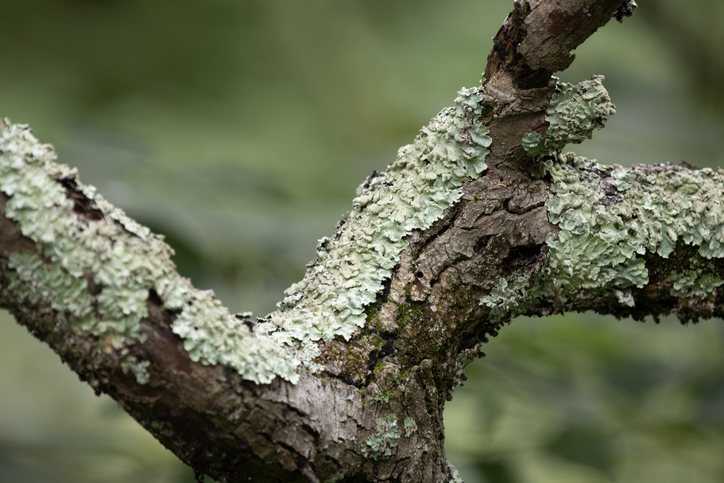
Lichen and moss growing on tree branches (Source: Jorge Figueiredo via iStockphoto).
Image - Text Version
Shown is a colour photograph of a tree with pale green, flaky-textured lichen, and dark green, soft textured moss growing on the bark.
The branches are wide and covered with thick, rough brown bark. The lichen grows across the top sides of each branch, while the moss grows along the bottom. More green vegetation is visible in the background, out of focus.
Some of the trees found in this biome include conifers such as spruce, fir, hemlock, larch and pine. There are also some deciduous trees, such as aspen, birch and willow. The mix of trees depends on which part of the world the forest is in. The boreal forest of North America is mostly spruces.
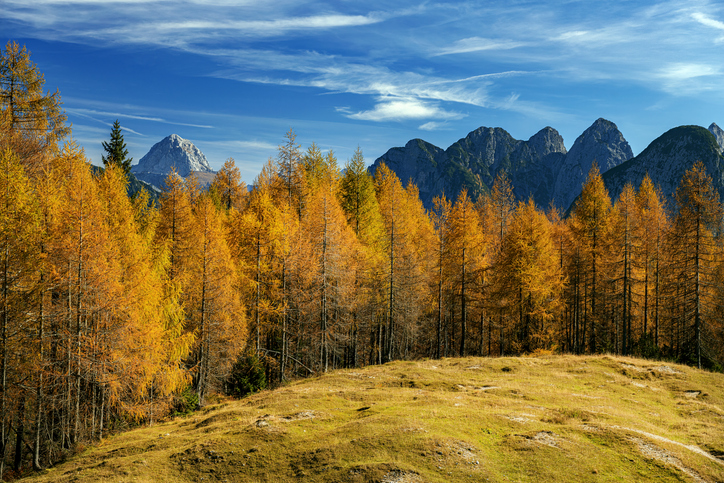
Larch forest in the autumn (Source: Pavliha via iStockphoto).
Image - Text Version
Shown is a colour photograph of clearing surrounded by trees with deep yellow and orange leaves.
The sun is low in the sky, and the grass on the clearing appears greenish gold. The trees behind are tall, straight, and teardrop-shaped. Their leaves are saturated shades of gold and orange. Above, a range of pointed, dark grey mountains are visible. The sky above is deep blue with wisps of white.
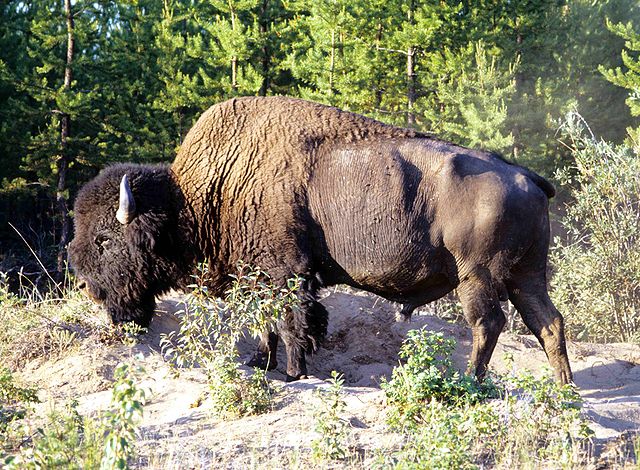
Wood bison (wood buffalo) at Wood Buffalo National Park. This is the largest national park in Canada (Source: Ansgar Walk [CC BY-SA] via Wikimedia Commons).
Image - Text Version
Shown is a colour photograph of a large brown animal with thick fur and small horns.
The animal's muscular hind legs are covered in thing brown fur. Its head and shoulders have much thicker fur. It has a hump at the top of its shoulders, and its head is lowered to the ground. Its head has dark brown, shaggy fur, and its horns are small, grey, and pointed.
There are coniferous trees in the background, and small green shrubs in the soil around.
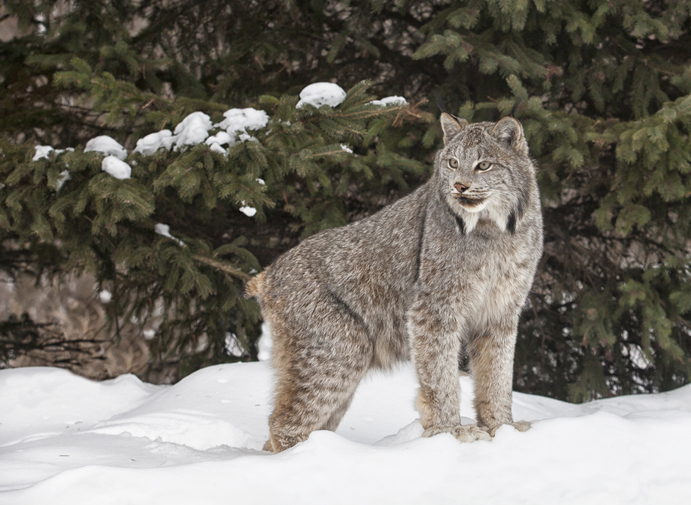
Canadian lynx in winter (Source: Lynn_Bystrom via iStockphoto).
Image - Text Version
Shown is a colour photograph of a large grey cat standing in snow.
The cat is much bigger and taller than a pet cat. It has thick, beige fur with grey spots, a short tail, and two pointed tufts of fur on its chin. It is looking intently to the left side of the image.
Smaller mammals, such as beavers, raccoons and voles also live here. Many species of birds use this biome for their nesting grounds.
Lakes and rivers provide a unique habitat for many migratory fish such as the North American Atlantic salmon. Finally, the forests, bogs and marshes of this biome are home to a large variety of insect life.
Human Impacts
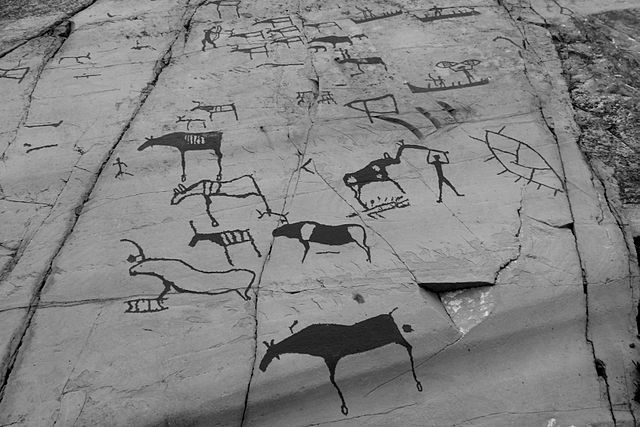
Rock drawings of humans hunting reindeer from Alta, Norway (dated 4000 BC) (Source: Jensvins [CC BY-SA] via Wikimedia Commons).
Image - Text Version
Shown is a black and white photograph of flat, smooth rock covered in drawings of large animals with horns, and humans.
The rock surface is covered in dozens of drawings in a deep, black colour. There are black animals with small horns, white animals with larger horns, and some with stripes across their ribcages. The humans are small stick figures. One is holding a club above their head.
Compared to some biomes, human impact on the boreal forest has been fairly small. This is because the cold climate makes it difficult for people to live there. In more recent times, as the number of humans living in this biome has increased, so has our impact. In general, humans have looked at the boreal forest as a source of natural resources. At the beginning, this meant cutting down trees for wood and mining different metals. More recently, this has expanded into oil and gas exploration and extraction.
Boreal Forests/Taigas and Climate Change
Human-induced climate change impacts both plants and animals living in boreal forests. For example, warmer, drier conditions are associated with climate change. This can cause more trees to die during the summer and insect populations to increase. Drought and forest fires are caused by warmer, drier forests.
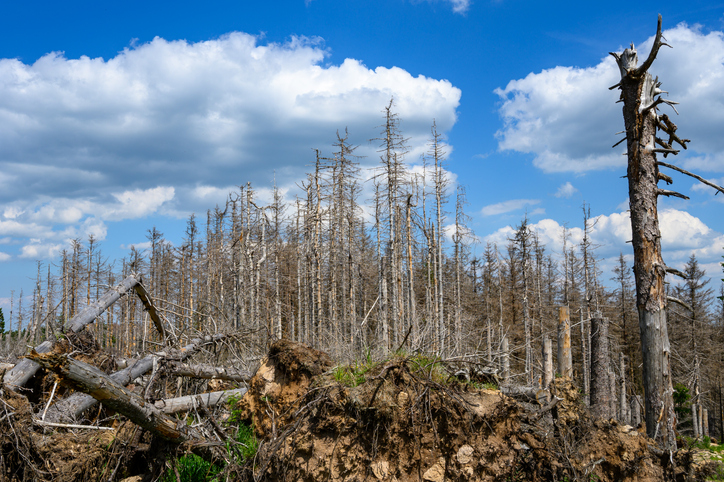
Dead pine trees (Source: ra-photos via iStockphoto).
Image - Text Version
Shown is a colour photograph of a forest with bare, grey, coniferous trees.
The trees are tall, thin, and densely packed. But the sky is visible between them. There are a few green needles still on the branches, but they are mostly bare.
In the foreground, there are fallen trees, green moss, and exposed beige soil. The sky above is deep blue with fluffy white clouds.
Conservation
Conservation groups, such as Boreal Conservation, are interested in helping this biome. These groups help others create sustainable solutions for Canada's boreal forests.
The Nature Conservancy is another group working to protect the Boreal Forest in Canada. Some of the actions this group is taking are:
- Indigenous Guardian program development;
- community-led land use planning;
- establishment of Indigenous protected areas;
- and youth-on-the-land programs.
Many programs aim to get communities and youth involved in conservation. This is an excellent way to make long-term positive impacts in the Boreal Forest.
Learn More
Clothing4Climate (Grades 7-10)
How do clothes affect the environment and climate change? This easy-to-use project allows teachers to implement student voice and choice seamlessly with minimal prep. At the same time, youth consider diverse perspectives on climate action, including Indigenous Ways of Knowing.
Exploring the Taiga Biome - FreeSchool (2022)
This YouTube video (8:42), from Free School, explores some of the fascinating animals and plants that are found in the Boreal Forest/Taiga biome.
Protect the Boreal Forest (2017)
This YouTube video (3:08 mins), from the NRDCflix, explores why it is important to protect the Boreal Forest.
Boreal Zone
This web page, from the Canadian Encyclopedia, is about taiga (boreal forest) including plants and animals.
References
Chen, Z. (2013). Boreal Forest and Taiga. In Howarth, R. W., & Mohan, J. E. Biomes and ecosystems (pp. 127-130). Salem Press.
Molles Jr., M.C. & Cahill Jr. J.F. (2015). Ecology: Concepts & Applications. Mcgraw-Hill Ryerson.
Shipigina, E., & Rees, W. G. (2011). Analysis of human impact on boreal vegetation around Monchegorsk, Kola peninsula, using automated remote sensing technique. Polar Record, 48(1), 94–106. DOI: 10.1017/s0032247411000556